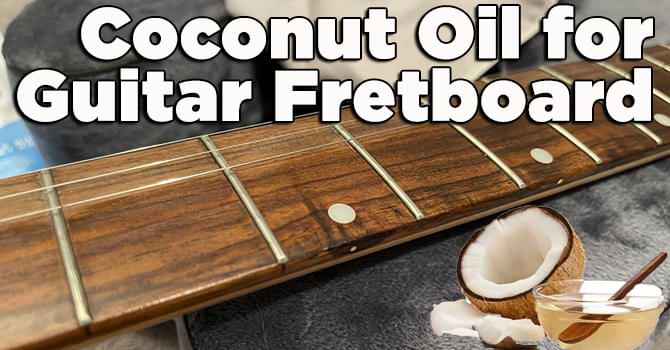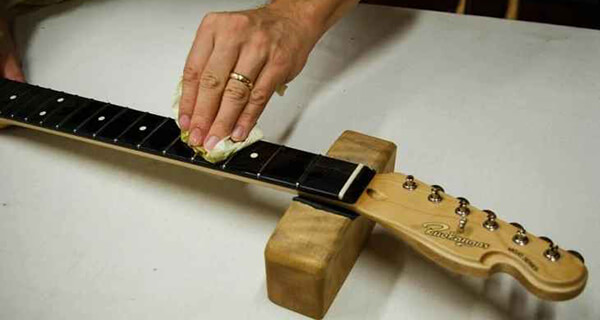Coconut Oil for Guitar Fretboard [Step by Step]
Maintaining your guitar’s fretboard is an essential aspect of preserving its playability, tone, and overall lifespan. Among the array of options available, one natural and versatile solution stands out: coconut oil.

In this guide, we’ll explore the benefits, proper application techniques, precautions, and alternative options associated with using coconut oil for guitar fretboard care. Discover how this readily available and affordable remedy can help you keep your instrument in optimal condition, ensuring a smoother, more harmonious playing experience.
# Table of Contents =>
Understanding Guitar Fretboard Care:
The guitar fretboard is not only the surface where you press down the strings to create different notes but also a crucial component of your guitar’s playability and tone. Neglecting its maintenance can lead to several issues. Frequent dryness is a prevalent issue, particularly in environments with low humidity levels.
This condition can lead to detrimental outcomes such as the wood cracking and shrinking. Furthermore, the accumulation of dirt and sweat over time can contribute to the development of an uneven, coarse playing surface that diminishes playing comfort.. Regular care ensures that your fretboard remains smooth, comfortable, and contributes to the best possible sound.
Benefits of Using Coconut Oil:
a) Natural Moisturization:
The inherent moisturizing qualities of coconut oil render it a superb option for nurturing a well-preserved fretboard. Upon application, coconut oil deeply permeates the wood, revitalizing any lost moisture and thwarting the onset of dryness and fragility. This significance is underscored by the potential consequences of a parched fretboard, including the emergence of cracks, fissures, and even alterations in the guitar’s intonation.
Through its moisturizing action, coconut oil aids in safeguarding the wood’s inherent strength, contributing to its sustained lifespan. As a result, the outcome is a smoother, more harmonious playing surface that optimizes the overall performance experience.
b) Mild Cleaning Properties:
Coconut oil’s gentle cleaning properties contribute to the upkeep of your guitar’s fretboard. As time goes by, the fretboard’s surface can gather a buildup of dirt, sweat, and other residues, which in turn can exert an adverse impact on both playability and tonal quality.
The application of coconut oil facilitates the dissolution and removal of these accumulated particles, all while ensuring that the wood remains unscathed and unaffected. This mild cleaning action not only contributes to a cleaner-looking fretboard but also ensures that the wood remains free from debris that could potentially affect its resonance and playability.
c) Readily Available:
One of the conveniences of using coconut oil for fretboard care is its widespread availability. Unlike some specialized guitar care products that might require a trip to a music store, coconut oil can often be found in many households’ kitchens.
This accessibility means that you can easily maintain your guitar’s fretboard without the need for a special purchase or waiting for a specific product to be delivered. Having readily available items for maintenance encourages regular care, which is essential for preserving your guitar’s condition.
d) Affordability:
Maintaining your guitar shouldn’t break and coconut oil fits this criterion perfectly. It’s an affordable option for fretboard care, especially when compared to some premium commercial guitar care products.
A small jar of pure coconut oil can go a long way, making it a cost-effective solution for players who want to keep their instruments in great shape without spending excessively on specialized products.
e) Non-Toxic:

Guitarists who are conscious of their health and the environment will appreciate coconut oil’s non-toxic nature. Unlike certain chemical-based products that might contain harsh solvents or additives, pure coconut oil is a natural substance that poses minimal risks to both you and the environment. This makes it a safe option for those who prefer to minimize their exposure to potentially harmful chemicals while still effectively caring for their instruments.
By highlighting these benefits, your readers can better understand why coconut oil is a versatile and effective choice for maintaining their guitar fretboards. Remember to provide practical tips and clear instructions on how to apply coconut oil for the best results.
Preparing the Fretboard:
Loosening the Strings:

Gently loosen the strings or remove them completely. This allows for better access to the entire fretboard surface.
Cleaning:
Cleaning: Employ a gentle, dry cloth or one slightly dampened to delicately eliminate dirt, dust, and grime from the fretboard’s surface. This step is pivotal in guaranteeing that the coconut oil can be administered to a pristine and untainted canvas.
Applying Coconut Oil to the Fretboard:
a) Choosing the Right Coconut Oil:
Opt for Unrefined, Pure Coconut Oil:

When selecting coconut oil for your fretboard care, it’s best to choose an unrefined, pure product. Avoid coconut oils with added scents, flavors, or additives, as these could potentially harm your fretboard or affect its playability.
Organic or unprocessed coconut oil has fewer impurities compared to alternate choices.
b) Application:
Utilize a Clean and Lint-Free Cloth:
Initiate the process by applying a modest quantity of coconut oil onto a cloth that is both clean and free of lint. This precaution is taken to prevent any debris or lint from transferring onto the fretboard during the application phase.
Gently Rub the Oil:

With the oil-dampened cloth, gently rub the coconut oil onto the entire surface of the fretboard. Make sure to cover both the wood and the frets, as the oil can help condition the metal frets as well.
Apply Sparingly:
A little coconut oil goes a long way. Avoid saturating the fretboard with too much oil, as excessive moisture can lead to issues down the line. Instead, apply a thin, even layer.
c) Absorption Time:
Allow Time for Absorption:
Subsequent to the application of coconut oil, allow it several minutes to undergo absorption into the wood. This process of absorption facilitates the oil’s penetration into the wood fibers, thereby contributing to the hydration and conditioning of the fretboard.
Wipe Off Excess Oil:
If you notice excess oil on the fretboard’s surface after the absorption time, gently wipe it away with a clean, dry cloth. This step is essential to prevent the accumulation of oil, which could potentially attract dirt or affect your playing experience.
d) Removing Excess Oil:
Gently Wipe Away Excess Oil:

After the absorption time has passed, use a clean and dry cloth to gently wipe away any excess oil that remains on the fretboard’s surface. Be thorough but gentle to avoid damaging the wood or frets.
Prevent Over-Saturation:
Removing excess oil is crucial for preventing over-saturation of the wood, which could lead to issues like fretboard warping, raised frets, or an uncomfortable playing surface. A thin and even layer of coconut oil is all that’s needed for effective fretboard care.
By following these guidelines, you’ll ensure that you’re applying coconut oil to your guitar’s fretboard effectively and responsibly. Proper application and care will contribute to maintaining the fretboard’s playability, appearance, and overall health.
Cautions and Considerations:
Wood Type:
Different woods, like rosewood and maple, may react differently to coconut oil. Check with the manufacturer’s recommendations or test in a small, inconspicuous area first.
Avoid Hardware and Finish:
Ensure that no coconut oil comes into contact with the guitar’s finish, hardware, or electronic components, as it could cause damage.
Regular Monitoring:
Continuously observe your fretboard’s condition. If it appears dry or starts to show signs of wear, apply coconut oil as needed.
Alternative Fretboard Care Options:
While coconut oil is a natural option, there are commercially available fretboard oils and conditioners specifically designed for guitar care. These products might have additional features or benefits, but they could also come at a higher cost.
Maintenance Schedule:
The frequency of coconut oil application depends on various factors, including:
- Climate: Dry climates might require more frequent applications.
- Playing Frequency: If you play regularly, consider applying coconut oil every few months.
Conclusion:
In the world of guitar care, coconut oil proves to be an unexpected yet effective ally for maintaining the health and longevity of your instrument’s fretboard. Its natural moisturizing and mild cleaning properties, coupled with its affordability and non-toxic nature, make it a standout choice among the available alternatives.
By incorporating coconut oil into your regular maintenance routine, you’re not only enhancing the playability and tone of your guitar but also indulging in a sustainable and holistic approach to fretboard care. Embrace this natural solution and ensure that your guitar remains a faithful companion, ready to produce beautiful music for years to come.
Last Updated on September 10, 2023 by Perry Garner


